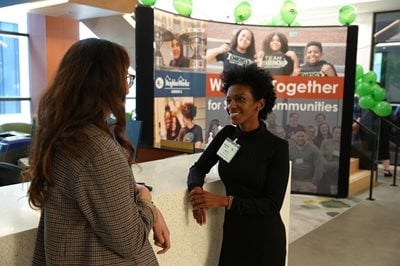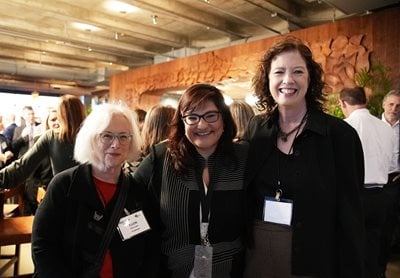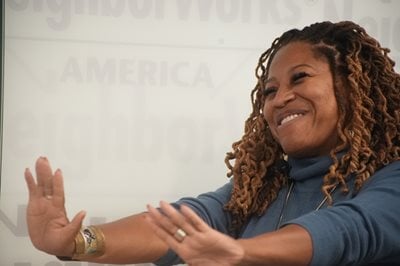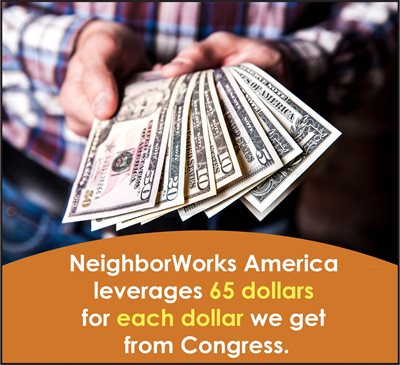 NeighborWorks America kicked off a yearlong observation of the organization’s 45th anniversary year this week, celebrating four and a half decades of partnerships and strengthening our communities. NeighborWorks provides support, training, assistance, grants and more to a network that works in neighborhoods across the country — and has done so even before becoming a Congressionally chartered nonprofit.
NeighborWorks America kicked off a yearlong observation of the organization’s 45th anniversary year this week, celebrating four and a half decades of partnerships and strengthening our communities. NeighborWorks provides support, training, assistance, grants and more to a network that works in neighborhoods across the country — and has done so even before becoming a Congressionally chartered nonprofit.
NeighborWorks’ President & CEO Marietta Rodriguez looked back on those years with pride, recounting the organization’s beginnings with Dorothy Mae Richardson, a Black homeowner in Pittsburgh, Pennsylvania who, with her neighbors, became frustrated when they could not access financing to improve their homes.
“They called business leaders and government leaders around the table to solve the issue,” forming a nonprofit and generating a revolving loan fund, Rodriguez said. NeighborWorks replicated that model.
The national nonprofit has seen many changes over the past 45 years, with 247 organizations representing every state, Washington, D.C. and Puerto Rico. The spirit of neighbors sitting around a table, shoulder to shoulder with business and government leaders is something NeighborWorks continues to support, Rodriguez said.
The philanthropy that supports nonprofits has also seen a lot of changes over the years. This week’s anniversary celebration included a deep conversation about philanthropy and trust between Rodriguez and Dr. Akilah Watkins, president and CEO of Independent Sector.
The two spoke at NeighborWorks’ D.C. headquarters in a room named in honor of Richardson’s legacy.
Room for trust
Rodriguez kicked off the discussion by acknowledging the changes community development organizations have faced in response to needs generated by the COVID-19 pandemic. She asked how philanthropy has responded. “COVID was a traumatic experience for the world and particularly for the community development sector because people had to hunker down in their homes,” said Watkins, whose Independent Sector brings together a diverse community of nonprofits, foundations and corporate giving programs. “We knew before COVID that we didn’t have enough homes for folks. We definitely felt that acutely during COVID.” As a result, philanthropy has grown more interested in housing policy. And the field’s response has included flexible funding and faith that nonprofits would know the best way to use it.
Seeing philanthropy provide such flexible support so quickly during difficult times “gave us hope that we could create new innovative models,” Watkins said.
She also spoke about how large, unrestricted gifts from funders such as MacKenzie Scott have changed the landscape. “In some ways, it was a powerful message to philanthropy that you can trust nonprofit leaders,” she said. The gifts gave nonprofits enough money to try new ideas and hire new staff, in a sense saying, “’Dream big. And here’s the money to support it.’” Nonprofits have been hoping for that kind of trust for years, she added.
At the same time, nonprofits that received the big dollars may have seen some of their regular donors turn elsewhere, leaving a smaller balance sheet. And, Watkins added, what happens when the large infusion of funding is no longer there? How do you keep paying new staff?

Crafting powerful narratives
Rodriguez asked how organizations that want to “take a moonshot” can position themselves to be noticed. Part of that, Watkins said, is telling the story of what you do and demonstrating outcomes.The complexity, she said, is to talk about work that has a triple bottom line: That we care about people, that we care about our business model, and that we care about the impact of what we do has on the world around us.
NeighborWorks, she added, taught her to tell that story while also showing how dollars are leveraged. (NeighborWorks was able to leverage $65 for each Congressional dollar spent in FY 2022.)
Navigating the Trust Gap
Rodriguez quoted Independent Sector’s recent suvey, which describes trust as the currency for the nonprofit sector. Nonprofits and small businesses maintain a high degree of trust, according to the survey, but over the past two years, there’s been a drop where nonprofits are concerned.“We’re seeing people’s feelings about their reality, their uncertainty about their financial future,” Watkins said. “It’s ironic that people who experience the nonprofit sector may not have as much trust in it if their financial future is bleak or uncertain. We’re worried about that.”
Another worry is the politicization of nonprofits, who are dealing with “the most complex challenges of our time.” It’s important to make sure problems and solutions are at the center of the dialogue, as opposed to politics.

But there are many opportunities in the industry now, too. One of those opportunities, since COVID placed the importance of home and housing so squarely in the spotlight, “is that we can reimagine what community can be. People are rethinking life, rethinking what community looks like.” That leaves room for the sector to be bold, to center equity and to move forward.
We saw during COVID how philanthropy can be more responsive, Watkins said. “We were able to solve real problems in real time.”
Another thing that came out of the pandemic? Hope.
For Rodriguez, that hope lies in the number of people who came out of the pandemic willing to engage around housing. “It’s much easier to pull resources together than it ever has been,” she said, and there’s an opportunity to be move across sectors.
Watkins sees hope in what she calls “dynamite new energy” coming into the community development sector. “It’s more diverse than it ever has been,” she said, adding that there are more women and people of color leading the industry. “I’m excited about some of the conversations we’re having that we didn’t have 20 years ago.”


